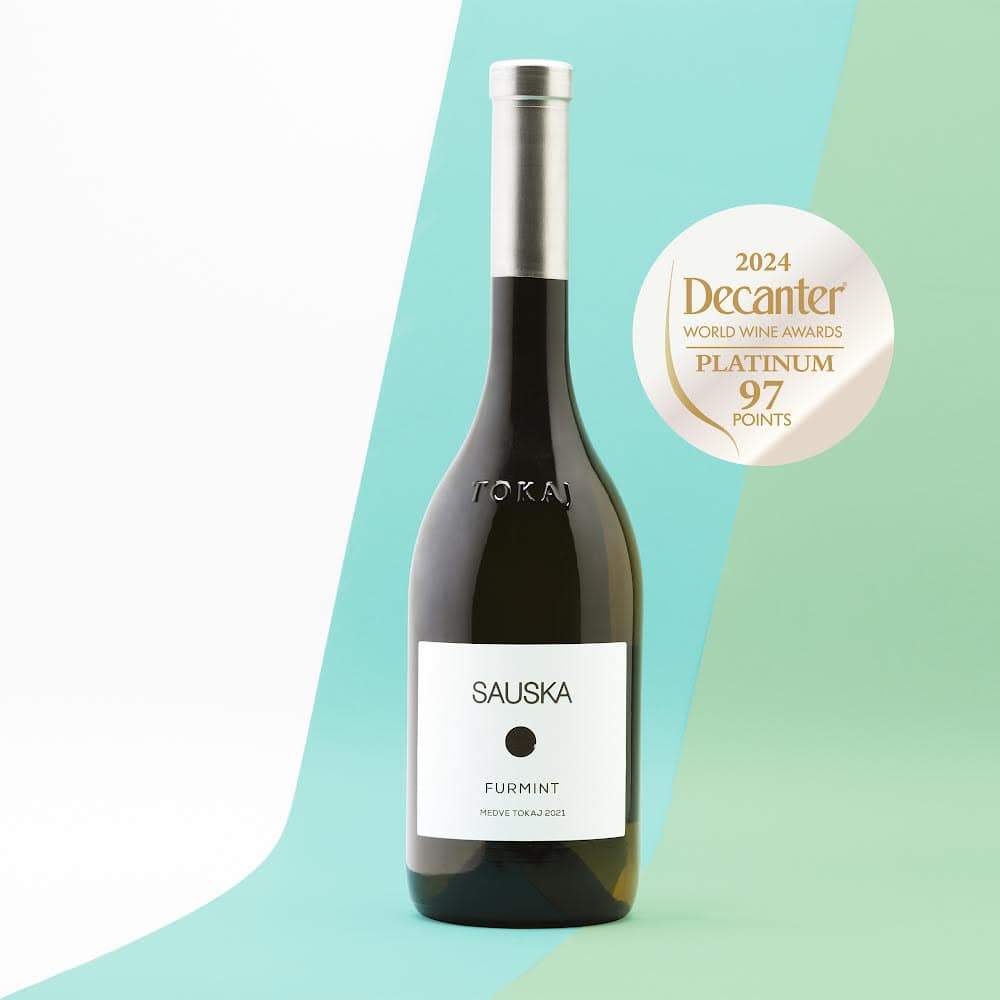
Furmint is the flagship wine – or maybe not?
 VinCE Magazine, Hungary’s leading wine magazine has a panel tasting each month, the latest issue dealt with dry Furmint wines. It is a delicate topic, since most of the winemakers are adamant on putting Furmint on the flags. They must be right: Furmint has distinctive characteristics regarding aromas and flavours, and its acidity makes it perfect for sweet wines, because the residual sugar is pleasantly balanced with its refreshing acidity.
VinCE Magazine, Hungary’s leading wine magazine has a panel tasting each month, the latest issue dealt with dry Furmint wines. It is a delicate topic, since most of the winemakers are adamant on putting Furmint on the flags. They must be right: Furmint has distinctive characteristics regarding aromas and flavours, and its acidity makes it perfect for sweet wines, because the residual sugar is pleasantly balanced with its refreshing acidity.
But what about ageing? The panel tasting of VinCE Magazine in the October issue was somehow surprising and unexpected: young Furmint wines proved to be attractive, even stunning, while the matured ones were questionable and dividing. The winner wine from Hétszőlő was probably the most dividing one: some adored it, while others were convinced that it had been over its peak.

Középhegy furmint
The Top 10 Furmint of VinCE Magazine Dry Furmint panel tasting:
- HÉTSZŐLŐ TOKAJI FURMINT SELECTION, 2011 – 17.00 points
- GRAND TOKAJ KŐVÁGÓ FURMINT, 2015 – 16.84 points
- MANDOLÁS, TOKAJ OREMUS, 2015 – 16.40 points
- APUKÁM BORA TOKAJI FURMINT, PRÉSELŐ BORHÁZ, 2015 – 16.24 points
- LAPOSA FURMINT, 2015 – 16.20 points
- DONAT MÁRGA, 2015 – 16.15 points
- TOKAJI FURMINT KÖZÉPHEGY, ZSIRAI, 2015 – 16.10 points
- TOKAJ DRY, HENYE, 2015 – 16.05 points
- MEDVE FURMINT, SAUSKA, 2015 – 16.03 points
- TOKAJI FURMINT, HÍMESUDVAR, 2015 – 16.02
As it can be clearly seen from the top chart, the latest vintage rules with the exception of the above mentioned winner. The aged dry Furmints received much lesser points and the members of the panel had a vivid discussion that the capability of Furmint for ageing might be questionable.

László Romsics
‘Some wines showed the atypical signes of ageing” – said László Romsics, consultant editor of VinCE Magazine and CEO of Csányi Winery, Villány. Dénes Uliczky wine expert, a counsellor to several winebars claimed that ‘The excessed use of oak barrel does not make any good to dry Furmint wines.’ Kata Zsirai from Zsirai Winery pointed out that ‘Furmint has a lot of faces nowadays. There are a lot of styles, but one unique style of Furmint cannot be distinguished.’ László Szilágyi, winemaker of Gizella Winery praised the vintage of 2015, mentioning its pleasant acidity, the airy character of the wines, the ripe fruitiness.
Furmint has a long history of fascinating wine experts. One of the latest speech on the topic was given by Demetri Walters MW from Berry Bros & Rudd at ProWein. He wrote afterwards: ‘I was thoroughly impressed by the wines and felt confident being an advocate and ambassador for Furmint.’
No doubt, Furmint has a lot of potential. Yet we have a lot to learn about it. We warmly recommend to all of our readers to give a try and drink Furmint!
The Following Chapter is an Excerpt From: Robinson, Jancis; Harding, Julia; Vouillamoz, Jose. “Wine Grapes (9780062325518).” iBooks.
FURMINT
The principal variety of the fiery, high-acid wines of Tokaj in Hungary.
Berry colour: white
PRINCIPAL SYNONYMS:
Fehér Furmint * (Tokaj), Lazafürtű Furmint * (Tokaj), Moslavac * or Moslavac Bijeli (Croatia), Mosler (Austria), Šipon (Slovenia, northern Croatia), Som (Transilvania), Szigeti, Tokay (France), Változó Furmint * (Tokaj), Zapfner or Zopfner (Germany)
VARIETIES COMMONLY MISTAKEN FOR FURMINT:
ALTESSE * (Savoie in France), GRASĂ DE COTNARI, KÉKNYELŰ * (Hungary), POŠIP BIJELI * (island of Korčula in Croatia), SAUVIGNONASSE * (northern Italy), ŽILAVKA * (Bosnia and Herzegovina”

ORIGINS AND PARENTAGE
Furmint originates from the Tokaj region in north-eastern Hungary, the home of the famous sweet Aszú wines (made from grapes affected by the benevolent form of botrytis bunch rot), whose existence was first documented on 15 May 1571 in the Hétszőlő vineyard in the village of Tokaj (Zelenák 2002). This wine most probably contained Furmint grapes because this variety was described as ‘die eigentliche Tokayer Trockenbeertraube’ (‘the genuine Tokaji Aszú grape’) by János Dercsényi (1796) and also because the variety name was recorded as early as 1611 in the Gyepű Valley near Erdőbénye in the Zempléni Mountains, about 20 km north of the village of Tokaj (Dienes 2001): ‘A Prédikátorsághoz vagyon három szőlő. Egyik Bakfű szőlő, másik Furmint szőlő a Giöpü völgyön, harmadik Hosszú szőlő’ (‘There are three vineyards for the preacher’s salary. One is the Bakfű vineyard, the other is the Furmint vineyard in the Gyepű Valley, the third one is the Hosszú vineyard’). According to the historian Dénes Dienes of the Sárospatak Calvinist College, who kindly provided translations and historical data, the first vineyard was named Bakfű, meaning ‘Purple Betony’ (Stachys officinalis), because this herb was grown on the land; the second vineyard, in the Gyepű Valley near Erdőbénye, was named Furmint because this variety was planted there; and the third vineyard was named Hosszú, meaning ‘long’, referring to its size. (In the seventeenth century the word szőlő meant not only ‘grape’ but also ‘vineyard’.)
However, and despite a few dubious hypotheses (see below), the etymology of Furmint is still unknown.
Several DNA parentage analyses (see PINOT pedigree diagram) have established that:
– Furmint has a parent–offspring relationship with GOUAIS BLANC (Boursiquot et al. 2004). Since Gouais Blanc was mentioned much earlier and was much more widespread throughout Europe in the Middle Ages, it is more likely that Furmint is its offspring, making Furmint a half-sibling of at least eighty other progenies of Gouais Blanc such as CHARDONNAY, GAMAY NOIR, ELBLING and RIESLING.
– Furmint has a parent–offspring relationship with HÁRSLEVELŰ (Calò, Costacurta et al. 2008; Vouillamoz), the other key variety in Tokaji wines. Since DNA profiling is not consistent with Furmint’s being a putative cross between GOUAIS BLANC and Hárslevelű, Furmint is therefore a parent of Hárslevelű.
– The same applies to the obscure PLANTSCHER in Switzerland, which is a natural progeny of Furmint (Vouillamoz, Maigre and Meredith 2004) and is a likely sibling of HÁRSLEVELŰ.”
“Studying the old varieties from Tokaj, Varga et al. (2008) have found four distinct types of Furmint with the same DNA profile: Fehér (‘white’), Lazafürtű (‘loose-bunched’), Piros (‘pink-berried’) and Változó (‘variable’). This high degree of genetic diversity speaks strongly in favour of the Tokaj region as the birthplace of Furmint.
Furmint was used to breed the wine-grape varieties BUSSANELLO, FUBIANO and VEGA in Italy and ZÉTA (formerly Orémus) in Hungary.
OTHER HYPOTHESES

Wine Grapes
Legend has it that Furmint was brought to Tokaj in the first half of the twelfth century by Italian missionaries who had been invited by King Stephen II (Fabbro et al. 2002), or around 1250 by Italian colonists from the city of Formia (Latin Formianum) in Lazio (Galet 2000). However, this is highly doubtful because Furmint has never been observed in Italy and has no genetic link with any other Italian varieties. The supposed etymology that derives Furmint from fiore dei monti (‘flower of the hills’) is equally improbable. Even more dubious is the story set during the Seven Years’ War (1756–63) about a soldier from Collio in Friuli, nicknamed Forment (Italian fromento means ‘wheat’) because of his reddish-blond beard, who was made Count of Formentin by Empress Maria Teresa in Tokaj and introduced Furmint from his homeland (Fabbro et al. 2002). This nice story can be eliminated simply because Furmint was mentioned in Hungary much earlier than the Seven Years’ War. Others have suggested a Balkan origin for Furmint (Syrmia, today’s Serbia), and even a Near Eastern origin has been proposed (Galet 2000), based on the mistaken belief that Furmint is the same as ALTESSE (see Altesse for details).”
VITICULTURAL CHARACTERISTICS
Early budding, late ripening. Loose bunches of medium-sized, thick-skinned berries. Susceptible to botrytis bunch rot and downy and powdery mildews and prone to frost damage, but good drought tolerance.
WHERE IT’S GROWN AND WHAT ITS WINE TASTES
Furmint is an intense variety producing world-class, fiery, full-bodied, high-acid, long-lived sweet and dry wines almost exclusively in Central Europe, especially Hungary. By 2010 there were just 9 ha (22 acres) of Furmint in Austria, mainly in Rust, near the Neusiedlersee in the far east of the country, where producers such as Heidi Schröck use it to make fine, sweet Ausbruch wines. Although it is still a rarity here, Furmint seems to appreciate the humidity, and plantings are likely to increase. Both Schröck and Triebaumer also make even rarer dry versions.
In Hungary it is the leading variety in Tokaj, with Somló in the far west of Hungary the only other area in which it is significant. Total plantings amounted to 4,006 ha (9,894 acres) in 2006, more than 97% in Tokaj. The combination of high acid, susceptibility to botrytis bunch rot and high sugar levels in the berries makes Furmint ideal raw material for intensely rich, long-lived Aszú dessert wines, often blended with the more aromatic HÁRSLEVELŰ and sometimes also a lesser amount of Sárga Muskotály (MUSCAT BLANC À PETITS GRAINS) and/or the more recent ZÉTA.
Furmint’s powerful dry wines, perhaps better able to reflect their exact place of origin than the sweet marvels, have received increased attention and renewed recognition in recent years. In Tokaj the best sites for this style – around Mád, Tolcsva and Rátka – have long been recognized, even before the sweet wines gained such a strong foothold. Recommended producers of both sweet and dry wines include István Balassa, Zoltán Demeter, Disznókő, Királyudvar, the Royal Tokaji Wine Company and István Szepsy in Tokaj plus Hollóvár in Somló.
There is a good deal of clonal variation and the better clones, generally those with smaller bunches that produce more concentrated wines, tend to be those planted before the Second World War: Madárkás, Holyagos and Féher Furmint (Rohály et al. 2003).
Just over the border from Tokaj, in Slovakia’s Tokajská, similar if more muted styles of sweet wines are produced from the more scattered vineyards there.
In Slovenia there were 694 ha (1,714 acres) of Šipon in 2009, mainly in Štajerska Slovenija (Slovenian Styria), in Podravje in the north east. Traditionally made as a dry wine, the variety can in good years yield sweet wines but not in the Tokaj style. Producers of fine dry wines include Dveri-Pax, Jeruzalem Ormož, Kupljen, Ljutomerčan, Pullus and Verus; Čurin-Prapotnik in the south east of the country and a few other smaller producers make sweet varietal wines.

Hungary’s leading wine magazine
Furmint is known as both Moslavac and Šipon in Croatia, where there were 422 ha (1,043 acres) in 2008 and the wines are almost always dry. It is generally known as Šipon in Medjimurje in the north, close to the Slovenian border. The Moslavac synonym derives from the Moslavina region, south east of Zagreb, where a handful of producers such as Miklavžić occasionally make a varietal wine, although it is more often found in blends and frequently overcropped. Miklavžić is also experimenting with a sparkling blend of Moslavac, CHARDONNAY and PINOT BLANC.
In South Africa, where Furmint was imported in tandem with the other Tokaji grape, HÁRSLEVELŰ, some fine wine has been made from low-yielding vines in the Swartland, notably Signal Hill’s Eszencia 2002.
Such a high-quality variety seems ripe for experimentation in other regions with a suitably long growing season.
Excerpt From: Robinson, Jancis; Harding, Julia; Vouillamoz, Jose. “Wine Grapes (9780062325518).” iBooks.






